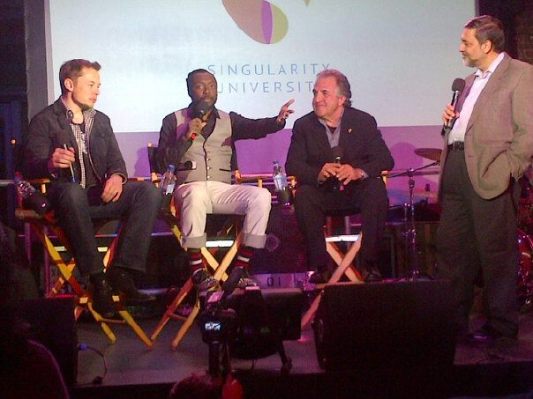Editor’s note: Professor Vivek Wadhwa is VP of Academics and Innovation at Singularity University; Fellow, Arthur & Toni Rembe Rock Center for Corporate Governance, Stanford University; Director of Research, Center for Entrepreneurship and Research Commercialization, Pratt School of Engineering, Duke University and Distinguished Visiting Scholar, Halle Institute of Global Learning, Emory University. Follow him on Twitter: @wadhwa.
Silicon Valley may be a garden of innovation, but many of the seeds were sown by Hollywood. Earlier generations of innovators were inspired by shows such as Star Trek, Lost in Space, and The Jetsons; later generations, by films such as Aliens, Terminator, and Avatar. Hollywood brought science fiction to the masses and gave people big things to dream about. And music spread the inspiration — it was a social network before social networks existed.
These were some of the things we discussed at the Singularity University executive program on the Mulberry Street set at Hollywood’s Fox Studios, last weekend. Entertainer and technologist will.i.am, Fox Filmed Entertainment Chairman and CEO Jim Gianopulos, and Tesla and SpaceX founder, Elon Musk, provided some amazing insights into the symbiotic relationship between Hollywood and Silicon Valley.
With the SOPA battles still fresh in their minds, many people in Silicon Valley view Hollywood as an evil entity seeking to limit how they watch the movies that they legally bought, or threatening to sue or shut down anyone who watches, searches for, or even thinks about a movie that may be pirated. Down South, Hollywood believes that it is fighting for survival; that rather than being grateful, Silicon Valley is behaving like a predator.
So where is the truth?
Let’s start with what Jim Gianopulos said about the role of science fiction in innovation (watch the video at the end of this post). I think he is right. I remember how I, as a child, would dream about using my “communicator” to talk to friends across the globe and my “replicator” to create fancy desserts; how I imagined travelling to distant worlds in my spaceship and talking to aliens through my “universal translator”.
Look at where we already are. As Rod Rodenberry said to me at the Fox event, the iPhone is even more advanced than what his father, Gene, had envisaged. Captain Kirk’s communicators didn’t receive emails, browse the web, or play music, after all. 3D printers can now “replicate” chocolates, human organs, and buildings. This printing technology is in its infancy, but watch what happens later in this decade. And then there is space travel. Elon Musk is developing not only the Tesla terrestrial sustainable transport vehicle (aka Tesla Roadster), but also spaceships for interplanetary travel using Star Trek-style thrusters (U.S.S. Enterprise version 1?). Elon plans to retire on Mars. He may well live his dream.
As well, will.i.am made intriguing comments about music’s role in innovation. He said that Hollywood was a marriage of art and science: the science to make the camera work and the art for the script. Silicon Valley hasn’t had its “art marriage” yet, but music has helped it evolve. Music has long spread ideas and inspired people to create. Will said music was the “spreading of inspiration”, “the first social network”.
Will too is right. Steve Jobs, for example, was a huge fan of Bob Dylan in particular and music in general. This passion may have influenced his decisions to build simple yet powerful music-creation software for the Mac. Try remembering when you heard a special song for the first time. You won’t be able to, but you’ll sure remember the circumstances—the point being that the art is essential for technology innovation.
So let’s give credit where it is due. We owe a lot to Hollywood.
On the flip side, the reason that big Hollywood names like Ashton Kutcher, will.i.am, John Cusack, and Troy Carter (Lady Gaga’s manager and ingenious strategist) wanted to attend our event is that they know what Silicon Valley has done for them. All the computer-generated effects, novel projection technologies, HD screens, and Dolby and THX sound systems were built to meet the needs of artists. Equally important, the tools from Silicon Valley have made it far easier to express artistic endeavors for fun and profit. The Blair Witch Project illustrated that a multimillion-dollar blockbuster could be shot on a camcorder.
The relationship between Hollywood and Silicon Valley is, in reality, quite symbiotic — SOPA and PIPA rage aside. It has to be, because Silicon Valley has yet to inspire great art, and Hollywood has yet to produce great technology. The two communities together, however, have powered the most important cultural movements of the past century. As Jim Gianopulos noted, the relationship suffers from periodic friction but is hardly a hatefest. In fact, the arts and entertainment have served as Silicon Valley’s muse for many, many years.
Online piracy is an issue that will continue to divide North and South California until solutions are found. Hollywood doesn’t want its films and music being pirated just as Silicon Valley doesn’t want its intellectual property being stolen. Neither wants the producers of counterfeit goods and fake drugs selling their wares to unsuspecting consumers.
Silicon Valley needs provide the leadership here. It needs to take note of Hollywood’s concerns and rein in the real bad guys.
